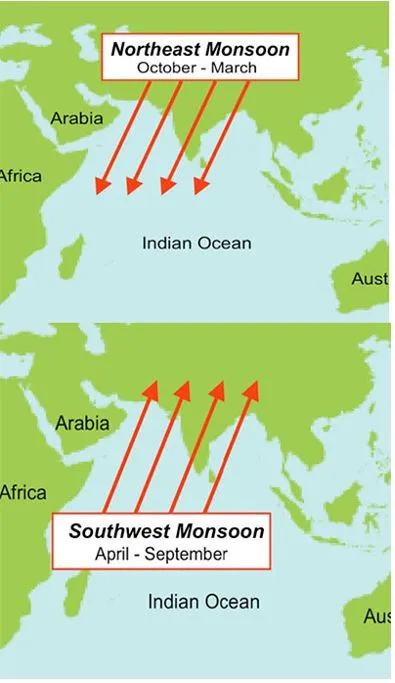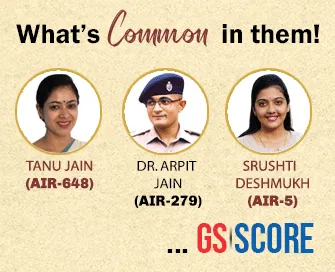

14th May 2025 (12 Topics)
Mains Issues
Context
The India Meteorological Department (IMD) recently announced the onset of the southwest monsoon over parts of the south Bay of Bengal and Andaman Sea. At the same time, meteorological signals are emerging that hint at a possible cyclone developing (Cyclone Shakti) over the Bay of Bengal. Though not yet confirmed, multiple systems—such as upper air cyclonic circulations and likely low-pressure areas—are forming, which could influence monsoon dynamics and weather patterns across the Indian subcontinent.
Key-highlights
- Southwest Monsoon Onset: The Southwest Monsoon, critical for India’s agriculture, has advanced into parts of the Bay of Bengal and Andaman Sea, signaling the start of its annual progression over the subcontinent.
- The northern limit of monsoon (NLM) is now traced through key coordinates, and further advancement is likely soon.
- Cyclonic Activity Over Bay of Bengal: A cyclonic circulation has been observed in the upper atmospheric layers over the Andaman Sea.
- IMD and regional meteorological centers are monitoring the formation of a low-pressure area, a precursor to potential cyclone development.
- A Bangladeshi meteorologist has forecasted the potential intensification into a full-fledged cyclone later in May, possibly to be named Cyclone ‘Shakti’.
- Widespread Weather Disturbances: Several upper air circulations have formed over northern and eastern India, influencing rainfall and thunderstorm patterns across states like Punjab, Delhi, Rajasthan, and the Northeast.
- The influence of these systems is expected to bring rainfall with thunder, lightning, and gusty winds in different regions, especially in northeast and southern India.
Southwest Monsoon:
- The Southwest Monsoon is the chief rainy season for the country.
- Over 70 per cent of the country receives the majority of its annual rainfall during the June to September season.
- Every year, the monsoon winds first arrive over the Andaman Sea and the Bay of Bengal around the third week of May and further progress into mainland India.
- Onset and progress: IMD declares the monsoon onset over India when it hits Kerala, where the normal onset date is June 1. Through June and mid-July, the monsoon brings continuous rainfall before covering the entire country by around July 15. This year, the monsoon onset over Kerala is expected to be early by 5 days and would be around May 27.
- Why Does the Monsoon Occur?
- Differential Heating of Land and Sea:During summer, the land (especially North India) heats up faster than the sea. This creates a low-pressure zone over land and high pressure over the Indian Ocean. Moisture-laden winds from the ocean move toward the land to fill this void.
- Inter-Tropical Convergence Zone (ITCZ):The ITCZ is a belt of low pressure near the equator where trade winds converge. In Indian summer, the ITCZ shifts northward (near the Tropic of Cancer) because the northern hemisphere is tilted toward the Sun. This pulls monsoon winds deep into the Indian subcontinent.
- Coriolis Force:Due to Earth’s rotation, the winds deflect to the right in the northern hemisphere. This turns the southeast trade winds into southwest monsoon winds over India.
- Other Climatic Factors Affecting Monsoon
- El Niño:Warming in central/east Pacific Ocean. It weakens Indian monsoon (can cause droughts)
- La Niña:Cooling in the Pacific. It strengthens monsoon
- Indian Ocean Dipole (IOD):Positive IOD (warmer west Indian Ocean). It enhances monsoon
- Equatorial Indian Ocean Oscillation: Affects monsoon build-up and variability
- Western Disturbances:Interact with monsoon and winter weather over North India



Mains Issues
Context
The United States has officially welcomed a group of Afrikaners from South Africa as ‘refugees’, citing racial discrimination against them in their home country.
Who are the Afrikaners?
- Afrikaners are descendants of mostly Dutch, French, and German settlers who arrived in South Africa between the 17th and 18th centuries.
- They speak Afrikaans, a language derived from Dutch, and have historically identified as a distinct white ethnic group with a deep-rooted presence in Africa.
- Historical Origins:
- In 1652, the Dutch East India Company set up a halfway station at the Cape of Good Hope to support trade with Asia.
- Early settlers included Dutch, French Huguenot (Protestants fleeing persecution), and Germans.
- The settlers also brought slaves from India, Indonesia, Madagascar, and East Africa, some of whom were absorbed into settler families through a practice called ‘paternalism’.
- These settlers gradually formed a unique identity, calling themselves Afrikaners or Boers (farmers).
Why is the US Accepting Afrikaners as Refugees?
According to the statement from the Trump-aligned administration:
- Afrikaners are considered a “vulnerable group facing unjust racial discrimination.”
- The move reflects the administration’s selective refugee policy, where priority is given to certain groups over others, often aligning with political and ideological narratives (e.g., Christian minorities from the Middle East, Cubans from Communist rule).
This decision has sparked accusations of racial bias:
- Critics argue that white Afrikaners, who have historically held power, are being prioritized over non-white refugees from conflict zones such as Sudan, Yemen, or Myanmar.
- The idea of Afrikaners as ‘refugees’ is itself contentious, as many still possess wealth, land, and relatively better living standards than most Black South Africans.
Refugee Definition:
India’s International Obligations:
|


Mains Issues
Context
Over the years, consumers in India and globally have faced increasing difficulties in repairing electronic products like smartphones, laptops, washing machines, and air conditioners. These products either break down frequently or are deliberately made difficult or expensive to repair—a practice known as planned obsolescence. As a result, consumers are often forced to buy new products instead of repairing existing ones, leading to financial strain and increased electronic waste.
What is the Right to Repair?
- The Right to Repair is a global movement demanding that:
- Consumers should be allowed to repair their products themselves or go to third-party repair shops.
- Companies should not monopolise repair services by limiting access to spare parts or repair information.
What has the Indian Government done recently?
- India has initiated steps toward formalising the Right to Repair through a new Repairability Index (RI), aimed at making electronic goods more consumer- and environment-friendly.
- The Department of Consumer Affairs (DoCA) has received a report on creating a "Repairability Index" (RI) for electronic goods.
- This Index would score products based on how easy they are to repair, taking into account:
- Availability and price of spare parts
- Access to repair manuals and technical documentation
- Software update availability
- Time and cost involved in repairs
The idea is that when consumers buy electronics, they will be able to see a repairability score (just like energy efficiency ratings) and choose products that are easier and cheaper to maintain.
Why is this important?
- Consumer Protection: Products should last longer or be easy to repair. Consumers are entitled to a fair choice and reasonable post-sale service.
- Cost of Living: Reducing the need to frequently replace gadgets or appliances will lower household expenses.
- Environmental Impact: Encouraging repair reduces electronic waste and decreases dependence on freshly mined ("virgin") metals—many of which India imports.
- Circular Economy: Repairing and recycling are key parts of India's efforts to move towards a circular economy, where materials are reused and reintegrated into the supply chain.
India vs. U.S. Approach:
|


Mains Issues
Context
In a significant trade development, India has formally notified the World Trade Organization (WTO) of its decision to suspend trade concessions extended to the United States. This move comes as a counteraction to continued U.S. safeguard tariffs on Indian steel, aluminium, and related products.
What are these U.S. Tariffs?
- Since 2018, the U.S. has imposed tariffs on steel and aluminium imports citing national security concerns (Section 232 of U.S. Trade Law).
- These tariffs were renewed in February 2025 through a presidential proclamation, continuing to hurt India’s exports.
- Although the U.S. presents them as “national security” measures, India classifies them as safeguard measures in disguise, meant to protect the U.S. industry from competition rather than security threats.
Why is India retaliating?
- India estimates that these tariffs have impacted USD 7.6 billion worth of Indian exports, resulting in USD 1.91 billion in additional duties paid by Indian exporters.
- India now seeks to recover this economic loss by increasing tariffs on selected U.S. products as a WTO-sanctioned countermeasure.
- India’s trade tools under WTO
- Retaliatory Tariffs: Suspension of concessions under WTO Articles
- WTO Dispute Settlement: Legal complaint to challenge WTO violations
- Bilateral Consultations: Attempt to resolve dispute before formal action
- Truce Agreements: Temporary resolution to avoid escalation
Key Concepts and Doctrines
|


Prelims Articles
Context
The Election Commission of India recently announced that it has resolved the issue of duplicate EPIC numbers in the electoral rolls, a problem that had persisted for years. This duplication posed risks to the integrity of elections by allowing the possibility of multiple voter entries under the same identification number.
What is an EPIC Number?
- EPIC stands for Electors Photo Identity Card.
- It is the 10-digit alphanumeric number on a voter ID card issued by the Election Commission of India (ECI).
- This number is meant to be unique for every voter, like a personal voter identity code.
- It helps ensure that a person can vote only once and in one constituency, avoiding impersonation or bogus voting.
- Problem:
- Duplication means that more than one voter had the same EPIC number, which defeats the very purpose of having a unique ID.
- This was a long-pending issue, especially in cases where:
- A person had moved between states or districts and re-registered.
- There were errors during the digitisation or migration of older voter lists.
- It posed risks like double voting, administrative confusion, and trust issues in the electoral process.


Prelims Articles
Context
India’s April 2025 retail inflation falling to 3.16%, which is the lowest since July 2019.
Key-findings
- Retail Inflation (CPI) fell to 3.16% in April 2025, the lowest since July 2019, down from 3.34% in March 2025.
- Food inflation declined to 1.78% from 2.69% in March.
- Vegetable prices dropped by 11% YoY, compared to 7.04% in March.
- Cereal price inflation slowed to 5.35% (from 5.93%), while pulses prices fell by 5.23% (vs. 2.73% fall in March).
- Economists expect inflation to remain around 3% in the next two months, aided by low commodity prices and expectations of an above-normal monsoon.
- The RBI may consider a 25 basis point rate cut in June 2025 due to easing inflation.
- RBI’s CPI inflation projection for FY 2025–26 is 4% average, with quarterly forecasts: Q1 – 3.6%, Q2 – 3.9%, Q3 – 3.8%, Q4 – 4.4%.
What is Retail Inflation?
- Retail Inflation is measured by tracking the price movements of several commodities being sold across India.
- CPI (Consumer Price Index)is a measure used to calculate retail inflation.
- It tracks the price changes of a basket of goods and services that households typically buy for everyday living. The CPI helps determine how much the cost of living has changed over a specific period.
- The CPI Formula is: (Price of basket in current period / Price of basket in base period) x 100
- This formula shows how much prices have increased or decreased compared to a reference period, which is called the base period.
- If CPI rises, it indicates inflation (prices have gone up). If CPI falls, it indicates deflation (prices have gone down).


Prelims Articles
Context
The Himachal Pradesh Government officially notified the Tsarap Chu Conservation Reserve under Section 36A(1) of the Wildlife (Protection) Act, 1972. This makes it the largest conservation reserve in India and a major biodiversity landmark in the fragile and remote Spiti Valley.
About
- Tsarap Chu is located in the Spiti Valley, a high-altitude cold desert in Lahaul and Spiti district of Himachal Pradesh.
- It lies near the border with Ladakh, and is surrounded by Kibber Wildlife Sanctuary to the east and Chandratal Wildlife Sanctuary to the west.
- It is at the confluence of the Unam River and Charap Nala and also acts as the catchment area of the Charap Nala.
- This area serves as a vital wildlife corridor, facilitating the movement of species between the Kibber and Chandratal
- The reserve is rich in high-altitude Himalayan biodiversity, offering critical habitat to several rare and endangered species.
- Flagship Species: Snow Leopard (Panthera uncia), Tibetan Wolf, Bharal (Blue Sheep), Himalayan Ibex, Kiang (Tibetan Wild Ass), and Tibetan Argali
- Avifauna: Rare and adapted bird species include the Rose Finch, Tibetan Raven, and Yellow-billed Chough, which indicate the region’s ornithological richness.
Conservation Reserve
National and Global Conservation Implications
|


Prelims Articles
Context
The rapid decline in insect populations, coupled with the challenges posed by invasive species and climate change, highlights the urgent need to understand species' evolutionary responses and ecological resilience. In particular, the Pacific field crickets' adaptation to an invasive parasitoid fly exemplifies the dynamic interplay of evolution under environmental pressures.
Key Findings:
- Insect Extinction Rates: Insects face extinction rates estimated to be eight times higher than birds, mammals, or reptiles, with populations declining in many regions globally.
- Invasive Species: Climate change is driving species to cross invisible natural borders, sometimes leading to the invasion of new ecosystems. These invasions disrupt native species, forcing them to either evolve or face extinction.
- Pacific Field Crickets’ Evolution:
- In Hawaii, Pacific field crickets have adapted to avoid predation from an invasive parasitoid fly (Ormia ochracea) by mutating their song.
- Some crickets now produce a muted song, while others have altered their song’s frequency and amplitude, allowing them to evade detection by the flies while still attracting mates.
- Fly Adaptation: The parasitoid flies are evolving rapidly in response, expanding their hearing range to detect a broader spectrum of sounds (from 4-6 kHz to 6-20 kHz), making it more challenging for crickets to avoid detection.
- Co-Evolution Dynamics: The evolutionary battle is not a straightforward, step-by-step process. The flies are not just tracking the crickets’ changes incrementally but are instead broadening their ability to detect a range of altered cricket sounds.
- Female Cricket Behavior: Female crickets have also become less selective about male songs, allowing the new mutated songs to be successful. Without this change, mutated males would have gone extinct locally.
- Insect Vulnerability: Insects are highly vulnerable to climate change and rapid evolution due to their short life cycles and fast reproduction rates. However, this makes them more susceptible to sudden environmental changes and extreme conditions.
- Global Threats to Species Adaptation: Climate change, extreme weather, and biological invasions are making it harder to predict how species will adapt to compounded pressures.
- Challenges for Long-term Survival: Rapid evolution in some species, such as insects, might explain why certain invaders succeed or why some species manage to adapt, offering insights into future ecological outcomes.
Species in Focus:
|


Prelims Articles
Context
Prime Minister Narendra Modi called for scaling up targeted interventions and successful strategies in early detection to eliminate tuberculosis (TB), while chairing a high-level meeting to review progress under the National TB Elimination Programme (NTEP).
About Tuberculosis (TB)
- TB is caused by a bacterium known as Mycobacterium tuberculosis, which belongs to a family of around 200 bacteria species called
- Types of TB:TB primarily affects the lungs (pulmonary TB) in humans. However, it can also affect other organs (extra-pulmonary TB).
- Historical Context:TB is an ancient disease, with evidence of its existence dating back to 3000 BC in Egypt.
- Treatability:TB is treatable and curable with appropriate medication and management.
- Transmission:TB spreads from person to person through the air. When individuals with lung TB cough, sneeze, or spit, they release TB germs into the air, which can be inhaled by others.
- Treatment: Current biomedical strategies to reduce new infections include the
- BCG vaccine, which protects against severe forms of childhood TB
- Tuberculosis preventive treatment (TPT) which aims to cover other household contacts, clinical-risk groups apart from children younger than five years and household contacts with HIV
- Effective rifamycin-based regimes
WHO’s Global Tuberculosis Report 2024
|


Editorials
Context
Though India has significant confrontation with Pakistan, New Delhi must look beyond its western neighbour to engage with the complex and evolving global geopolitical dynamics. The rise of multipolarity, great power politics involving the US, China, and Russia, and Trump’s transactional diplomacy demand a recalibrated Indian foreign policy outlook.
Shifting Global Alignments and Power Triangles
- Russia-China Strategic Convergence: Amid India-Pakistan tensions, Xi Jinping and Vladimir Putin reaffirmed their deepening strategic ties, calling themselves “friends of steel” and vowing to build a post-American order, despite both engaging separately with the US.
- US-China Trade 'Ceasefire': While South Asia witnessed military escalation, the US and China negotiated a pause in their trade war, signifying the fluid and pragmatic nature of global power engagements.
- Complex Power Geometry: These developments mark a departure from ideological camps. Today’s world order is shaped less by fixed alliances and more by transactional, multipolar equations where strategic flexibility matters more than bloc-based thinking.
Trump’s Transactional Diplomacy and Gulf Outreach
- Arabian Peninsula Tour & Big Money Diplomacy: President Trump’s Middle East visit aims to secure over USD 2 trillion in investments and arms deals from Saudi Arabia, UAE, and Qatar—aligning foreign policy with domestic economic objectives.
- Business and Foreign Policy Blurring: Trump’s personal and familial business interests—such as the USD 5.5 billion Qatari golf project—blend with statecraft, underscoring the thoroughly transactional nature of his diplomacy.
- Iran Dealings and Regional Balancing: While courting Gulf states, Trump also engages Iran, holding multiple rounds of backchannel negotiations. This double-track diplomacy enhances US leverage and frustrates traditional US allies like Israel.
Implications for India’s Foreign Policy
- Beyond Pakistan-Centric Focus: While India must enforce red lines on Pakistan-based terror, it must not be consumed by this binary. The world is moving in multiple directions simultaneously.
- Strategic Maturity Needed: The oversimplified lens of “friends vs foes” is inadequate. India must enhance its understanding of triangular and multipolar power plays and invest in domain expertise and negotiation capacity.
- Strengthening Diplomatic Institutions: In a world governed by complex bargaining and shifting alliances, undermining India’s professional diplomatic corps would be self-defeating. India needs skilled diplomacy to pursue strategic autonomy and global relevance.
Practice Question
Q. In light of the changing global order marked by transactional diplomacy and shifting power triangles, evaluate how India should recalibrate its foreign policy strategy beyond a Pakistan-centric lens. What institutional and strategic reforms are needed to engage with emerging global dynamics?

Editorials
Context
Despite the ambitious goals of the National Education Policy (NEP) 2020, India’s education system continues to suffer from low graduate employability, poor industry linkage, and lack of innovation outputs. Critics argue that the system produces degrees with little market value and fails to meet the evolving demands of a knowledge-based economy.
Systemic Flaws in Vision and Policy Execution
- Employability Crisis Ignored by NEP: The NEP 2020, hailed as an “educational renaissance”, ignores the shape-shifting needs of the job market, leading to a 2025 graduate employability rate of only 6%, nearly unchanged from 44.3% in 2023.
- Lip Service to Reforms, Lacking Implementation: Despite promising flexibility (multiple entry/exit points), the NEP has only enabled low-quality e-commerce jobs without systemic pedagogical reform or skilling infrastructure.
- Absence of Industry Representation in Policy Formulation: The committee drafting NEP lacked any member from industry or the business sector, resulting in policy formulations detached from economic realities and employment demands.
Research Quality, Rankings, and Accountability Deficit
- Misleading Higher Education Rankings: Although 11 Indian universities entered the QS Top 500, India’s Category Normalized Citation Impact (CNCI) remains poor—ranked 16th out of 19 G-20 countries, reflecting low research quality despite increased quantity.
- Non-Transparent Megaprojects with Public Funds: Projects like IMPRINT, Akash tablet, and CSIR-NMITLI were launched with great publicity but lack publicly available data on outcomes, raising concerns about value-for-money and accountability.
- GII and Innovation Cluster Weaknesses: In the Global Innovation Index (GII) 2024, India ranked 39, behind Malaysia (33) and Türkiye (37). India’s top innovation clusters, like Bengaluru (Rank 56), perform far below global leaders like Cambridge (1) or Silicon Valley (6).
- Misunderstood Start-Up Ecosystem: Unlike global startups tackling deep-tech challenges, Indian start-ups often revolve around food delivery or digital marketplaces, lacking a foundation in indigenous science and technology.
- UGC as a Barrier, Not a Facilitator: The University Grants Commission (UGC) retains both regulatory and financial control, but fails to show any empirical data linking pedagogy reforms to employability or skilling improvements.
- Education Sans Depth, Breadth, and Methodology: While NEP claims to offer flexible curricula, it neither ensures depth (technical expertise) nor breadth (interdisciplinary agility), critical in the AI-driven and constantly evolving job market.
Practice Question:
Q. Critically examine the challenges posed by the current educational policy framework in ensuring employability in India. How can depth and breadth in higher education be balanced to meet the demands of a knowledge-based economy?

Editorials
Context
A temporary trade agreement was announced between the U.S. and China—two of the world's largest economies—where both nations agreed to scale back tariffs significantly for 90 days. This marks a significant pause in the otherwise escalating global trade tensions.
Key Features of the U.S.-China Agreement
- Tariff Reductions Announced: The U.S. reduced its average tariff on Chinese goods from 145% to 30% for a 90-day period, while China reduced tariffs on American imports from 125% to 10%.
- Market Reaction: Global stock markets rallied by 2% to 3.8% in response, signaling investor optimism over easing trade tensions between the two economic giants.
- Context of Prior Tensions: The agreement follows months of escalating tariffs, including President Trump’s February 1 move for variable tariffs and a selective April pause that excluded China, worsening bilateral strains.
Strategic Interpretations of U.S. Actions
- Possible Retreat by the U.S.: The deal may reflect Trump’s recognition of China’s importance to the U.S. economy, suggesting a softening of his aggressive trade stance.
- Coercive Strategy Outcome: Alternatively, it may indicate that Trump’s high-pressure tariff strategy succeeded in compelling China to negotiate under economic duress.
- Core Issue Unresolved: The U.S. trade deficit with China, Trump’s central concern, remains untouched, with both sides only agreeing to continue further dialogue.
Implications for India
- Challenge to China+1 Strategy: If U.S.-China ties improve, China regains its competitive edge in global manufacturing, further sidelining India’s incomplete leverage of the China+1 model.
- S.-India Trade Frictions: India has formally notified the WTO of reciprocal tariffs on U.S. steel and aluminium, highlighting the fragile nature of current U.S.-India trade talks.
- Structural Hindrances Remain: India’s growing trade deficit with China, coupled with weak land and labour reforms, impedes its ability to scale cost-effective domestic manufacturing.
Practice Question
Q. In light of the recent U.S.-China trade truce, critically examine its implications for India’s trade competitiveness and policy strategy. Also discuss the structural reforms required to reduce India's overdependence on Chinese imports.


